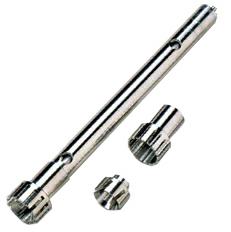Selecting Lab Homogenizer Generator Options
Laboratory homogenizers are called upon to perform a tremendous variety of mixing, dispersing, emulsifying, and similar operations in research and pilot plant studies across many industries. Part of the specification process when considering the purchase of lab homogenizers is the size and power of the drive motor. Size and power, along with speed control, relate to the volume and often the viscosity of samples being processed.
 The Homogenizer Rotor-Stator Generator
The Homogenizer Rotor-Stator Generator
Next on the spec list is choosing the configuration(s) of the homogenizer rotor-stator generator(s). This is a two-part assembly. The first is the rotor shaft powered by the drive motor. The top of the shaft clicks into the drive motor housing while the bottom is a precision machined rotor with multiple and extremely sharp blades. This is housed in a tube fixed to the drive motor itself by using a hand-tightened holding knob. The second part is at the base of the tube and is called the stator assembly. It is also precision machined with sharp edges that compliment the rotor design.
Keep in mind that rotor configuration and stator configuration can be changed out as homogenizing requirements change. The stator can be removed by unscrewing it from the tube; the rotor and its shaft can likewise be changed out for a different configuration designed for the stator. Tools are available for this exercise.
CAT Homogenizer Tool Options
Picking the right tool for the job applies most anywhere, and lab homogenizers are no exception. There are a number of criteria to be evaluated. Note that in selecting homogenizer tools you must take into account several factors including volume, speed, viscosity, and the drive motors suitable for the process. Once you’ve established your objectives you’ll narrow down the options in making the correct selection.
1. What is the objective of the homogenizing process? These tools are used to emulsify, disrupt, disperse, disintegrate and otherwise reduce samples for further processing.
2. What is the property of the material involved? CAT dispersing tools are designed to work with medium, low and fine viscosity materials as well as a knife configuration for stringy or fibrous materials.
3. What about sealed or non-sealed shafts and bearings? While bearings are common in all shafts to keep the rotor rod centered, shaft seals protect O-rings, ball bearings, springs, retaining rings, discs, and other delicate components from harsh or abrasive media.
4. What type of shaft tube do you need – with or without ports? Ports are useful as they allow media to circulate and cool the assembly. Use tubes without ports when working with samples under pressure, in a vacuum or for use with abrasive or adhesive type media.
5. What is the size of your mixing container? This will govern the length and diameter of the entire generator assembly. CAT offers assemblies from 105 to 360mm long and diameters from 6 to 20mm.
6. What is the proper drive motor for your generator? Not all generator assembles are suitable for all drive motors.
7. Etc.
Confused? Let us help you specify the correct homogenizer generator assembly. The time you take to compete or homogenizer questionnaire will be well spent compared to the aggravation of making the wrong decision.
